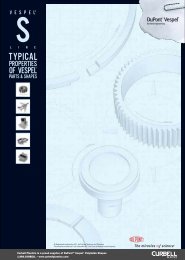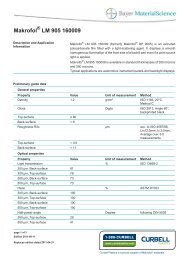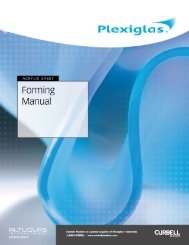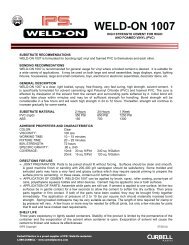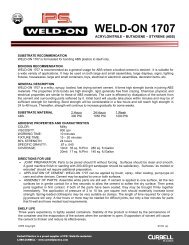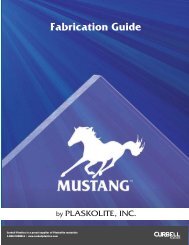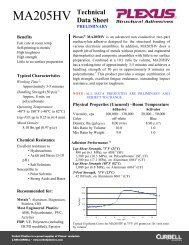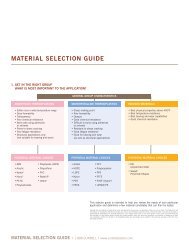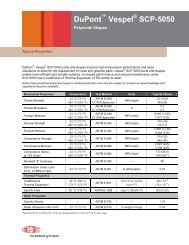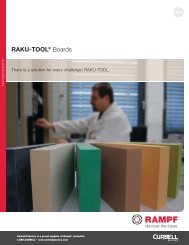Acrylite Acrylic Sheet Fabrication - Curbellplastics.com
Acrylite Acrylic Sheet Fabrication - Curbellplastics.com
Acrylite Acrylic Sheet Fabrication - Curbellplastics.com
- No tags were found...
Create successful ePaper yourself
Turn your PDF publications into a flip-book with our unique Google optimized e-Paper software.
The following table summarizes the features of different heating methods.Heat Source Initial Cost Efficiency Average Life (hrs)Coiled nichrome wire Very inexpensive Poor 1,500Metal (cal) rod Inexpensive Fair 3,000Hot air ovens Moderate Poor N/ACeramic elements Moderate Good 10,000Quartz Tube:Nichrome filament High Excellent 20,000Tungsten filament High Outstanding 10,000Forced convection hot air heatingThis method is usually used for heavier gauge sheet as well as in applications with very high optical requirementssuch as aircraft windshields. If the sheet is to be heated vertically, sufficient clamping pressures should be used toprevent sheet slippage from the clamp as the material softens. Vertical heating generally is not re<strong>com</strong>mended forcontinuously manufactured or extruded sheet because the sheet could fall out of the clamps as it softens. Cell castsheet has sufficient melt strength to prevent it from falling out of the clamps. If the sheet is to be heated horizontally,the horizontal surface must be clean and free of defects, as any imperfection on the surface will appear on the finalpart. A clean plate of glass covered with talk powder can be used a surface for horizontal heating.Before heating with an air oven, be sure that:Temperature can be controlledthermostatically within ± 10°F (±5°C)between 140-350°F.Air velocities across the sheet rangebetween 200-1000 feet per minute (1-5 m/s).Temperatures throughout the oven areuniform.The clamping system exerts constant,uniform pressure on all sides as the sheetbe<strong>com</strong>es soft.As a general rule, a sheet should be heated in an air convectionoven for 1 minute per 0.010” of thickness. Below is a chartoutlining re<strong>com</strong>mended heating times for different thicknesses.Infrared radiant heatingThis heating method is used for thin and medium thickness sheet and is the most efficient heating method. Whendesigning a horizontal heating system, independently controlled zones can be set up to improve control and flexibility.In such a setup heaters in the perimeter zones can be set to a higher output than those in the center zone. This willensure uniform heating of the sheet.Infrared radiation refers to electromagnetic waves with a wavelength greater than 710 nm. The wavelength at which asheet absorbs the most energy varies depending on the material. Proper selection of heating elements and temperaturescan be ac<strong>com</strong>plished by matching the peaks in the infrared spectra of the heating elements with the low pointsin the IR transmission curve of the sheet material. Below is a chart showing the infrared transmission for acrylic.%5



